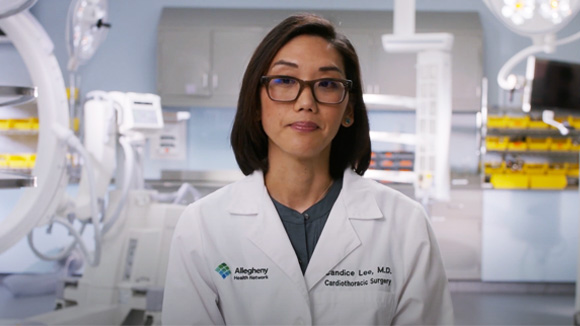Chronic Thromboembolic Pulmonary Hypertension (CTEPH)
What is CTEPH?
Chronic thromboembolic pulmonary hypertension (CTEPH) is a rare form of pulmonary hypertension (PH), or high blood pressure in the lungs. CTEPH occurs when pulmonary embolisms (PE) — or blood clots — block blood vessels in the lung for a long time. Many people with CTEPH are unaware they have these blood clots. Left untreated, CTEPH can be fatal.
Allegheny Health Network (AHN) Cardiovascular Institute is among an elite group of medical programs in the country — and the only one in western Pennsylvania — with the expertise to perform two highly advanced surgical procedures to treat, and often cure, CTEPH.
CTEPH symptoms
Chronic thromboembolic pulmonary hypertension symptoms may include:
- Shortness of breath, especially during exercise.
- Pain or palpitations in the chest.
- Chronic fatigue.
- Feeling weak or fainting.
- Cyanosis (blue coloration on the fingers and toes).
- Swelling of the legs.
- Coughing up blood.

"The way that this is typically diagnosed is through a ventilation profusion scan which allows us to visualize areas of the lung that are getting oxygenated but blood flow is not getting there due to blood clots or scarring."
Candice Lee, MD — Thoracic and Cardiac Surgery
Causes of chronic thromboembolic pulmonary hypertension
CTEPH happens because of repeated blood clots or blood clots in the lungs that don’t completely dissolve. These cause blockages in the artery and over time leads to scar tissue and other changes in the blood vessels in the lungs. This results in high blood pressure in the lungs and makes it difficult for the right heart to pump blood properly, which can weaken your heart muscle over time. Factors that can increase your chances of getting blood clots are:
- Staying sedentary for a prolonged amount of time.
- Undergoing surgery.
- Cancer.
- Smoking.
- Birth control with estrogen.
- Obesity.
Risk factors for CTEPH
Many people who develop pulmonary hypertension after having a pulmonary embolism go through a “honeymoon period” with few, if any, symptoms. Risk factors for developing CTEPH include:
- Large blood clot or more than one embolism episode.
- Previous surgical removal of the spleen (splenectomy).
- Chronic inflammatory diseases, such as inflammatory bowel disease and osteomyelitis.
- History of cancer.
- Hypercoagulability disorders.
- Female gender.
CTEPH care at AHN: Why choose us?
We have a dedicated team of PH specialists who excel in diagnosing and treating the most complex PH condition, CTEPH. Our CTEPH program provides exceptional patient results. You can receive dedicated care at the accredited AHN Pulmonary Hypertension Program.
Diagnosis of CTEPH
CTEPH may be suspected based on clinical history and echocardiogram findings of PH. Diagnosis of CTEPH is determined by a series of tests including:
Echocardiogram
Also referred to as an echo, this test uses high-frequency soundwaves to create a graphic outline of the heart in motion.
Ventilation-perfusion (VQ) scan
Used to confirm CTEPH, a VQ scan uses intravenous and inhaled radioactive materials to pinpoint blood clots in the lungs.
Right heart catheterization
Also called pulmonary artery catheterization, this test is used to see how well your heart is pumping, how much it pumps per minute, and to measure the blood pressure in your heart and lungs.
Pulmonary angiography
Similar to a heart catheterization, this is a catheterization to visualize abnormalities of the arteries in your lungs (pulmonary arteries). Your physician takes X-ray pictures while injecting a contrast dye into the pulmonary arteries.
Dual energy computed tomography angiography (CTA)
This test combines CTA with 3D reconstruction of pulmonary arteries to look for clots. This procedure requires the injection of a contrast dye.

"We have a multidisciplinary team of specialists in cardiovascular medicine, anesthesia, cardiac surgery, pulmonology, and critical care medicine that approach each patient individually to come up with the best treatment plan for them."
Candice Lee, MD — Thoracic and Cardiac Surgery
CTEPH treatment and surgery
The Cardiovascular Institute’s CTEPH surgery center is among an exclusive group of medical centers worldwide to provide highly complex surgical procedures for CTEPH. These treatments include:
Pulmonary thromboendarterectomy (PTE)
During this intricate procedure involving open-heart surgery, your physician surgically removes old blood clots and scar tissue from arterial branches in the lungs. This procedure can potentially cure CTEPH. AHN physicians evaluate all patients with CTEPH for this procedure. The decision to perform PTE is based on several factors, including:
- Severity of symptoms.
- Pulmonary blood pressure readings.
- Ability to surgically access the diseased areas in the pulmonary arteries.
- Co-existing medical conditions.
Balloon pulmonary angioplasty (BPA)
Your physician may recommend this minimally invasive procedure if health problems or other factors make CTEPH surgery, or PTE, too risky. Over a period of a couple of weeks, your physician uses a catheter with a small balloon on the tip to gradually open up the pulmonary arteries.
Dedicated team of CTEPH experts
Our board-certified physicians in cardiology, pulmonary medicine, cardiothoracic surgery, radiology, critical care medicine, and rheumatology work with PH specialists to provide you with all-inclusive care. A dedicated nurse navigator guides you throughout the diagnosis and treatment process.
Living with CTEPH: Life expectancy and prognosis
When left untreated, the CTEPH prognosis is very poor. The average CTEPH life expectancy is between one to three years. However, PTE surgery can potentially cure CTEPH. For patients who are not candidates for PTE surgery, there are specific medications, sometimes combined with BPA procedures, that can improve CTEPH symptoms.
Contact us
Call (412) DOCTORS (412) 362-8677 or request an appointment with AHN cardiovascular services.
-
Appointments
Cardiovascular Institute(412) DOCTORS
By accessing this video, I understand that I am leaving the AHN website and I will be re-directed to an external website operated by a third party platform provider. I acknowledge that the platform provider may collect personal information about me, and about the video that I view, on their platform and may use and disclose this information in accordance with its privacy policy. I agree that Allegheny Health Network is not responsible for the data collection and use practices of this third party.

